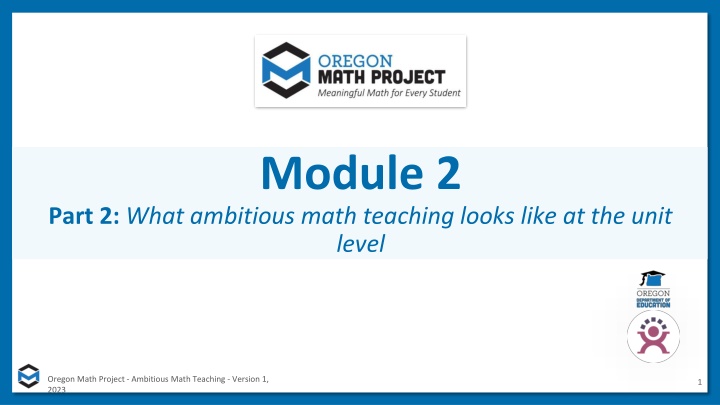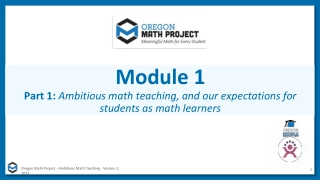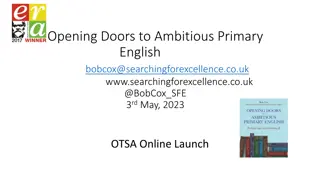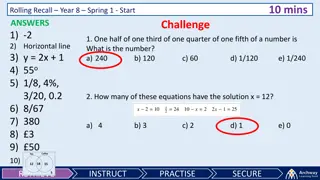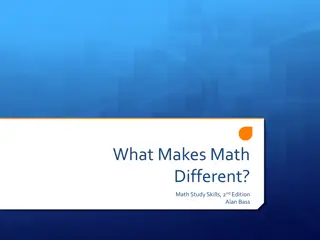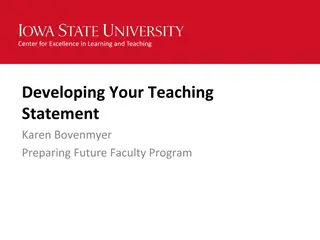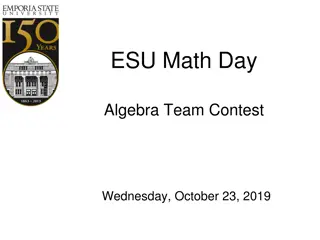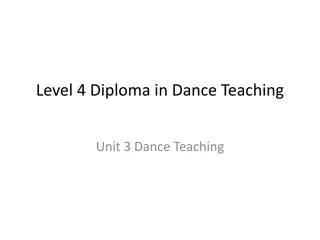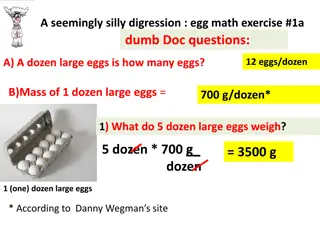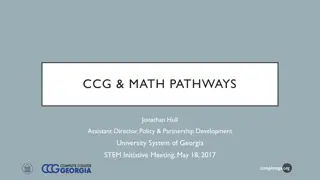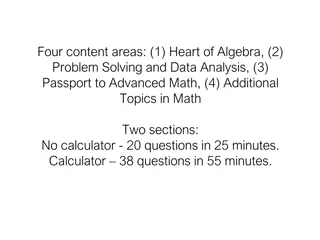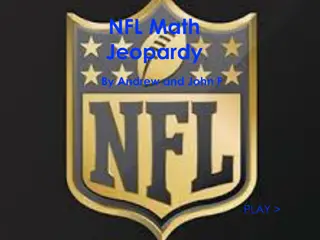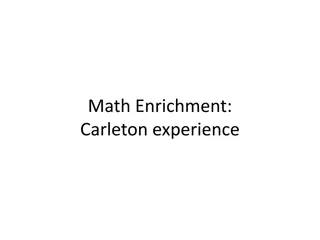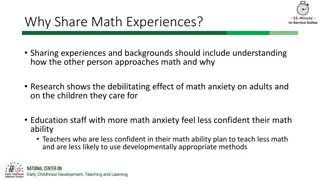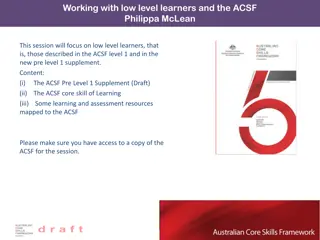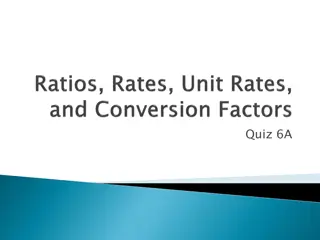Ambitious Math Teaching at Unit Level - Session 10 Agenda
In Session 10 of the Oregon Math Project, educators focus on engaging students in rich grade-level content through ambitious math teaching. The agenda includes setting norms, collaborative math activities, connecting to research, and planning classroom implementation. Emphasis is placed on supporting students in accessing and mastering grade-level math concepts.
Download Presentation

Please find below an Image/Link to download the presentation.
The content on the website is provided AS IS for your information and personal use only. It may not be sold, licensed, or shared on other websites without obtaining consent from the author.If you encounter any issues during the download, it is possible that the publisher has removed the file from their server.
You are allowed to download the files provided on this website for personal or commercial use, subject to the condition that they are used lawfully. All files are the property of their respective owners.
The content on the website is provided AS IS for your information and personal use only. It may not be sold, licensed, or shared on other websites without obtaining consent from the author.
E N D
Presentation Transcript
Module 2 Part 2: What ambitious math teaching looks like at the unit level Oregon Math Project - Ambitious Math Teaching - Version 1, 2023 1
Essential Questions of the Modules What is ambitious math teaching? Why is a 2 + 1 model important for equitable outcomes in mathematics? Module 1: Foundations of High School Math Instruction What does ambitious math teaching look like at the unit, lesson, and task levels? How do we value and build on the mathematical strengths of students who are often excluded by schooling? Module 2: Principles and Practices of Ambitious Math Teaching What planning, teaching, and assessment practices can be used to sustain ambitious math teaching? Module 3: Principles and Practices of Sustainability 5 Oregon Math Project - Ambitious Math Teaching - Version 1, 2023
Reconnecting to our thinking from the previous sessions Oregon Math Project - Ambitious Math Teaching - Version 1, 2023 6
Session 10 The focus of this session is to consider how we might plan in ways that engage students in rich grade level content. Ambitious math teaching at the unit level: Planning to support students in accessing grade level content Agenda for this session: 1. Setting and maintaining norms: Reconnect with and revise our norms for interacting together 2. Doing math together: Experiencing an activity which can engage all students in grade level content ( Which one is unique and why? ; Algebra) 3. Connecting to research: Scaffolding and supporting to give students access to grade level content 4. Planning for action: Applying our learning to our work in the classroom Time estimate:75 minutes M2 P2 Table of Contents 7 Oregon Math Project - Ambitious Math Teaching - Version 1, 2023
Setting and maintaining norms Reconnect with and revise our norms for interacting together 8 Oregon Math Project - Ambitious Math Teaching - Version 1, 2023
Revisiting norms [Insert your group norms] Rights of a Learner You have the right to: Be confused Make mistakes Say what makes sense to you Share unfinished or rough draft thinking and not be judged (Kalinec-Craig, 2017) 10 Oregon Math Project - Ambitious Math Teaching - Version 1, 2023
Doing math together: Which one is unique and why? Experiencing an activity which can engage all students in grade level content. Oregon Math Project - Ambitious Math Teaching - Version 1, 2023 11
Which one is unique and why? Goals for us as math learners: Mathematical goal: Use key features of parabolas to create equations. Equity goal: Use reasoning, technology, and rough draft thinking to give learners opportunities for higher level thinking when finding the unique properties of different parabolas. 13 Oregon Math Project - Ambitious Math Teaching - Version 1, 2023
Which one is unique and why? Goals for us as teachers: Equity goal: Understand how structures like Which One is Unique? Why? provide access to grade level content and make space for multiple perspectives which helps us elevate the status of students who are often excluded by schooling. Pedagogical goal: Notice how teachers can use structure to support justification and mathematical thinking. 14 Oregon Math Project - Ambitious Math Teaching - Version 1, 2023
Which one is unique? Why? A B C D Oregon Math Project - Ambitious Math Teaching - Version 1, 2023 15
Small Group Activity Directions: Work with your group to justify why each image could be considered unique. Oregon Math Project - Ambitious Math Teaching - Version 1, 2023 16
Justify why each of the following graphs could be the one that is unique? Which One is Unique? Why? B A A B C D C D Oregon Math Project - Ambitious Math Teaching - Version 1, 2023
Which One is Unique? Why? Justify why each of the following graphs could be the one that is unique? B: INSERT IDEAS FROM SMALL GROUPS A: INSERT IDEAS FROM SMALL GROUPS A B C: INSERT IDEAS FROM SMALL GROUPS C D D: INSERT IDEAS FROM SMALL GROUPS Oregon Math Project - Ambitious Math Teaching - Version 1, 2023 18
What might the equations for each graphs look like? A B C D Oregon Math Project - Ambitious Math Teaching - Version 1, 2023 19
Small Group Activity Directions: Work with your team to use Desmos or a graphing calculator to find an approximate equation for each graph. Oregon Math Project - Ambitious Math Teaching - Version 1, 2023 20
Preview of Workspace Slide Use Desmos or a graphing calculator to find an approximate equation for each of the following. Be prepared to share your mathematical reasoning. Desmos https://www.desmos.com/calculator Be ready to share Your equations and your strategies for finding them. A: B: C: D: One new insight you have as a result of investigating this. Oregon Math Project - Ambitious Math Teaching - Version 1, 2023 21
Debriefing Which one is unique and why? Goals for us as math learners: Mathematical goal: Use key features of parabolas to create equations. Equity goal: Use reasoning, technology, and rough draft thinking to give learners opportunities for higher level thinking when finding the unique properties of different parabolas. Discuss: 1. How did you see me working on each of these goals during the lesson? 2. What moves was I making as a teacher of mathematics? 3. What moves could have been made to support our work on these goals even more? 23 Oregon Math Project - Ambitious Math Teaching - Version 1, 2023
Debriefing Which one is unique and why? Goals for us as teachers: Equity goal: Understand how structures like Which One is Unique? Why? provide access to grade level content and make space for multiple perspectives which helps us elevate the status of students who are often excluded from rich mathematics by schooling. Pedagogical goal: Notice how teachers can use structure to support justification and mathematical thinking. Discuss: 1. What new ideas do you have about what reasoning and sensemaking look like and sounds like? 2. What questions do you have about supporting students reasoning and sensemaking? 24 Oregon Math Project - Ambitious Math Teaching - Version 1, 2023
Debrief: Habits of mind and interaction Which of these habits did you notice? What others could have been highlighted? In what ways? Habits of Mind: Things we do as individual mathematicians when solving problems. v Habits of Interaction: Things that we do when working with others to make sense of the math. 2 5 (TDG, 2020) Oregon Math Project - Ambitious Math Teaching - Version 1, 2023
Debrief: Practices of ambitious mathematics teaching Which of these 8 practices did you notice? What others could have been highlighted? In what ways? 1. Establish mathematical goals to focus learning 2. Implement tasks that promote reasoning and problem solving 3. Use and connect mathematical representations 4. Facilitate meaningful mathematical discourse 5. Pose purposeful questions 6. Build on procedural fluency from conceptual understanding 7. Support productive struggle in learning mathematics 8. Elicit and use evidence of student thinking v (NCTM, 2014) Oregon Math Project - Ambitious Math Teaching - Version 1, 2023
Connecting to research Scaffolding and supporting to give students access to grade level content Oregon Math Project - Ambitious Math Teaching - Version 1, 2023 27
Continuing the Journey: Mathematics Learning 2021 and Beyond Let s create greater opportunities for all students to learn and have access to grade level content. (NCTM, NCSM, 2021) Oregon Math Project - Ambitious Math Teaching - Version 1, 2023 29
Mathematics Learning & Beyond In teams of 3, read pages 2-4, 5-6, 7-9 and jigsaw what you learned. Consider while you read: What additional work do teachers need to do when planning units and lessons to ensure that students who are often excluded from rich mathematics by schooling have access to the grade level content? (NCTM, NCSM, 2021) Oregon Math Project - Ambitious Math Teaching - Version 1, 2023 30
Small Group Activity Directions: Spend 10 min privately to read your section of Continuing the Journey and then spend 3 minutes each to share key ideas referring to specific paragraphs. Oregon Math Project - Ambitious Math Teaching - Version 1, 2023 31
Team Names: Preview of workspace slide For each section of the article, jot down notes related to the following prompt: What additional work do teachers need to do when planning units and lessons to ensure that students who are often excluded from rich mathematics by schooling have access to the grade level content? Key ideas from pages 2-4 Key ideas from pages 5-6 Key ideas from pages 7-9 Oregon Math Project - Ambitious Math Teaching - Version 1, 2023 32
Key ideas from Continuing the Journey The role and relationship between mathematical content and practices in supporting students learning Shifting away from remediation and instead offering supports and scaffolding The differences between remediation and supports/scaffolding Oregon Math Project - Ambitious Math Teaching - Version 1, 2023 33
Mathematical content, process, and practices Students opportunities to engage in mathematical practices and processes are co-equal partners with the specific content priorities for a course or a grade level (NCTM, 2021). Students should therefore have opportunities to: make sense of mathematical problems and persevere in solving them; reason abstractly and quantitatively; construct viable arguments and critique the reasoning of others using precise language; use mathematics to model the world; and develop generalizations (NCTM, NCSM, 2021) Oregon Math Project - Ambitious Math Teaching - Version 1, 2023 34
Shifting from remediation to supporting and scaffolding Students who are viewed as struggling often never get to more engaging rigorous mathematics. When teachers believe that certain knowledge is a prerequisite in order to engage with grade level content, students may miss out on important content and practices because they are constantly engaged in remediation instead. When teachers leverage students strengths and existing knowledge to help them make sense of and access mathematical concepts and contexts they can support all students in engaging with rich grade level mathematics. (NCTM, NCSM, 2021) Oregon Math Project - Ambitious Math Teaching - Version 1, 2023 35
What do we mean by scaffolding? Scaffolding: Supports the immediate construction of knowledge by the learner; Provides the basis for the future independent learning of the individual Make tasks accessible without lowering the cognitive demand, the type of questioning used, or ways of promoting mathematical discourse. Scaffolding vs. Remediation Research shows that just-in-case remediation increases, rather than decreases, gaps in student achievement, whereas just-in time scaffolding supports and values student knowledge while being intentional to ensure success with grade-level content (TNTP 2018). Begin the year with grade-level content and instruction and include opportunities for just-in-time scaffolds and support. Rather than thinking about what students need before they can do grade level work, ask What do students know about the world/mathematics that can help them make sense of this grade level idea? Weave in content from prior grade levels as needed. v (NCTM, NCSM, 2021) Oregon Math Project - Ambitious Math Teaching - Version 1, 2023 36 36
Addressing students needs These are Elementary Standards. Would this look differently if it were High School examples? Why or why not? (Adapted from TNTP, 2020) Oregon Math Project - Ambitious Math Teaching - Version 1, 2023 37
Debrief: Principles of ambitious mathematics teaching Which of these ideas are you thinking about in light of our work? What questions do you have? Ambitious teaching: Engages students in making sense of mathematical concepts Centers students thinking and reasoning through discourse Views students as capable of using their understandings and assets to solve authentic problems Values students thinking, including emergent understanding and errors Attends to student thinking in an equitable and responsive manner Ambitious teaching is teaching that deliberately aims for all students across ethnic, racial, class, and gender categories not only to acquire, but also to understand and use knowledge, and to use it to solve authentic problems. (Lampert & Graziani, 2009, p. 492) (Anthony et al., 2015) Oregon Math Project - Ambitious Math Teaching - Version 1, 2023
Planning for action: Applying our learning to our work in the classroom 39 Oregon Math Project - Ambitious Math Teaching - Version 1, 2023
Applying our learning to our work in the classroom 1. Work with a partner/group or independently to reflect on the unit of instruction you are currently working on: How do the ideas from the Continuing the Journey article relate to your work teaching this unit? What new ideas do you have about remediation vs. scaffolding? How might these ideas apply to your current unit of instruction now or in the future? - - 1. Make at least one change to your current unit plan with a colleague based on your conversation. Be sure you schedule time for a quick follow-up about how trying this idea out went between now and our next session (i.e., at your next PLC meeting) 41 Oregon Math Project - Ambitious Math Teaching - Version 1, 2023
Debriefing Session 10 Reflecting on our work in the activities in the session 42 Oregon Math Project - Ambitious Math Teaching - Version 1, 2023
Debriefing Session 10: Four cornerstone principles of the OMP What connections do you see between any of the cornerstones and our work in this session? Focus: Learning experiences in every grade and course are focused on core mathematical content and practices that progress purposefully across grade levels. Any proposed instructional approach, curricular change, or system design element should be evaluated by the degree to which it builds on these four cornerstones. When new approaches are built within the framework of all four-cornerstone principles, we will be on our way to engineering a reimagined system. Engagement: Mathematical learning happens in environments that motivate all students to engage with relevant and meaningful issues in the world around them. v Pathways: All students are equipped with the mathematical knowledge and skills necessary to identify and productively pursue any postsecondary paths in their future. Students have agency to choose from a variety of courses, contexts, and applications they find relevant. Belonging: Participation in mathematical learning builds students identities as capable math learners and fosters a positive self-concept. Students cultural and linguistic assets are valued in ways that contribute to a sense of belonging to a community of learners. (ODE, 2022) Oregon Math Project - Ambitious Math Teaching - Version 1, 2023
Debriefing Session 10: Focus of the session What new insights do you have related to our session focus, planning to support students in accessing rich grade level content? Take a couple of minutes to reflect on our work in the session. Agenda for this session: 1. Setting and maintaining norms: Reconnect with and revise our norms for interacting together 2. Doing math together: Experiencing an activity which can engage all students in grade level content ( Which one is unique and why? ; Algebra) 3. Connecting to research: Scaffolding and supporting to give students access to grade level content 4. Planning for action: Applying our learning to our work in the classroom v Oregon Math Project - Ambitious Math Teaching - Version 1, 2023
Goal: The purpose of this section is to practice planning ambitious units of instruction which support students in accessing grade level content. Section 11 Ambitious math instruction at the unit level: Planning a unit that supports students in accessing grade level content Agenda for this section: 1. Connecting to research: Using the Oregon Math Standards to plan units which support students in accessing grade level content 2. Planning for Action: Using a unit planning protocol to plan units of instruction which support students in accessing grade level content Time estimate: 90-120 minutes Oregon Math Project - Ambitious Math Teaching - Version 1, 2023 45
Connecting to research: Using the Oregon Math Standards to plan units which support students in accessing grade level content 46 Oregon Math Project - Ambitious Math Teaching - Version 1, 2023
Start planning with the standards The first step in planning a unit that supports ambitious instruction, is a acquiring a clear understanding of the mathematical content students will be working on. In the slides that follow, explore the revised Oregon Mathematics Standards, in order to build familiarity with the tools and resources that can support you in making sense of the standards. 48 Oregon Math Project - Ambitious Math Teaching - Version 1, 2023
Revisions to the standards Key revisions from the previously adopted mathematics standards as of October, 2021 include: Addition of a K-12 Data Reasoning Domain Merging of measurement content with Geometry content Revision of K-12 domains to reflect the learning pathways of Algebraic Reasoning, Numeric Reasoning, Geometric Reasoning & Measurement, and Data Reasoning Identification of a core two credit requirement in high school that aligns to the Oregon 2+1 course design The transition from the 2010 standards to the 2021 standards will occur in the 2021-22 and 2022-23 school years, with updated materials used by students in the fall of the 2023-24 school year. Link to more information from the Oregon Department of Education regarding Mathematics Standards Oregon Math Project - Ambitious Math Teaching - Version 1, 2023 49
Exploring the K-12 Math Standards Guidance Document Link to the K-12 Math Standards with Clarifying Guidance What is in the Guidance Document? SECTION ONE: Introduction SECTION TWO: Adopted 2021 Math Practices SECTION THREE: Adopted 2021 Oregon Mathematics Standards SECTION FOUR: Grade and Standards Level Guidance SECTION FIVE: Oregon/CCSS Crosswalk v Oregon Math Project - Ambitious Math Teaching - Version 1, 2023 50
Small Group Activity Directions: Explore the K-12 Standards Guidance Documents. Oregon Math Project - Ambitious Math Teaching - Version 1, 2023 51
Team Names: Preview of Workspace Slide Record any new ideas, a-has, or questions you have related to each section of the standards document: Reflection: How do you see the standards as related to the Cornerstones? SECTION 1: SECTION 2: SECTION 3: SECTION 4: SECTION 5: Oregon Math Project - Ambitious Math Teaching (Module 2) DRAFT VERSION for 2022-23 - Final Version Posted in July 2023 52
Start at the BEGINNING BEGIN Standards Guidance Document Exploration Oregon Math Project - Ambitious Math Teaching (Module 2) DRAFT VERSION for 2022-23 - Final Version Posted in July 2023 53
Exploring the K-12 Math Standards Guidance Document Link to the K-12 Math Standards with Clarifying Guidance What is in the Guidance Document? SECTION ONE: Introduction SECTION TWO: Adopted 2021 Math Practices SECTION THREE: Adopted 2021 Oregon Mathematics Standards SECTION FOUR: Grade and Standards Level Guidance SECTION FIVE: Oregon/CCSS Crosswalk v Oregon Math Project - Ambitious Math Teaching - Version 1, 2023 54
Exploring the K-12 Math Standards Guidance Document Link to the K-12 Math Standards with Clarifying Guidance What is in the Guidance Document? SECTION ONE: Introduction SECTION TWO: Adopted 2021 Math Practices SECTION THREE: Adopted 2021 Oregon Mathematics Standards SECTION FOUR: Grade and Standards Level Guidance SECTION FIVE: Oregon/CCSS Crosswalk v Oregon Math Project - Ambitious Math Teaching - Version 1, 2023 55
SECTION TWO: 2021 Adopted Math Practice Standards (p. 17) Link to the K-12 Math Standards with Clarifying Guidance MP.1: Make sense of problems and persevere in solving them. MP.2: Reason abstractly and quantitatively. MP.3: Construct viable arguments and critique the reasoning of others. MP.4: Model with mathematics. MP.5: Use appropriate tools strategically. MP.6: Attend to precision. MP.7: Look for and make use of structure. MP.8: Look for and express regularity in repeated reasoning Oregon Math Project - Ambitious Math Teaching - Version 1, 2023 56
Exploring the K-12 Math Standards Guidance Document Link to the K-12 Math Standards with Clarifying Guidance What is in the Guidance Document? SECTION ONE: Introduction SECTION TWO: Adopted 2021 Math Practices SECTION THREE: Adopted 2021 Oregon Mathematics Standards SECTION FOUR: Grade and Standards Level Guidance SECTION FIVE: Oregon/CCSS Crosswalk v Oregon Math Project - Ambitious Math Teaching - Version 1, 2023 57
SECTION THREE: Adopted 2021 Oregon Mathematics Standards The 2021 Oregon Mathematics Standards are organized into grade level content for K-8 and within the domains of algebra, geometry, and data science/statistics for high school. v Oregon Math Project - Ambitious Math Teaching - Version 1, 2023 58
SECTION THREE: Adopted 2021 Oregon Mathematics Standards (p. 6) Link to the K-12 Math Standards with Clarifying Guidance The 2021 Oregon Mathematics Standards are organized into grade level content for K-8 and within the domains of algebra, geometry, and data science/statistics for high school. Key Definitions for unpacking the standards: Standards define what students should understand and be able to do. Clusters summarize groups of related standards. Note that standards from different clusters may sometimes be closely related, because mathematics is a connected subject. Domains are larger groups of related standards. Standards from different domains may sometimes be closely related. v Oregon Math Project - Ambitious Math Teaching - Version 1, 2023 59
